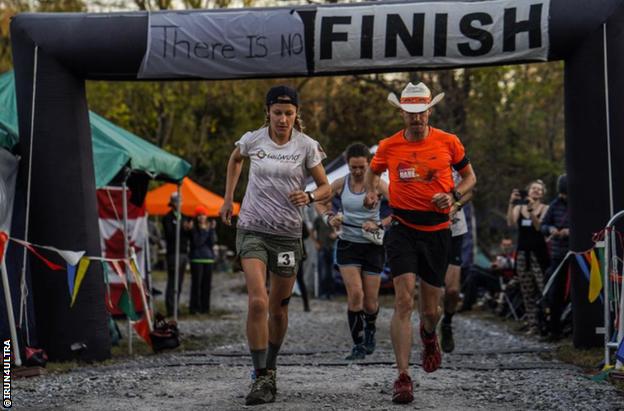
Think you can run 4.16666 miles in an hour? Probably.
Could you do it again the following hour? Quite possibly.
How about the hour after that? The legs might be feeling it by now.
What if you had to do it every hour for the next two or three days?
It’s hard to say exactly how long you’ll be running for – because this race only finishes when there’s one person left standing.
The trouble is, some runners can keep going for quite a long time. The current record – held by a Belgian dentist – is 75 hours, or 312 miles.
Welcome to Big Dog’s Backyard Ultra, the toughest – and weirdest – race you’ve never heard of.

First, the name.
Big Dog is race organiser Gary Cantrell’s pet bulldog, who spends most of his time snoozing under a table at the start-finish line, barely lifting a droopy eyelid as dozens of sleep-deprived runners shuffle past him day and night.
The backyard is Cantrell and wife Sandra’s sprawling farm in Bell Buckle, rural Tennessee, where runners complete a loop of the woods every hour during the day, before switching to an out-and-back route on the road at night for safety reasons.
And ‘ultra’ is surely the most apt title for a race in which someone can run for 300 miles yet still be classed as a Did Not Finish.
“It’s like being punched in the face,” chuckles Cantrell from his kitchen via Zoom. “Not hard, just a little bit. But you do it again, and again, and again. Eventually you start to flinch when you see the punch coming.”
Guillaume Calmettes, a French software engineer who ran 245 miles – 59 hours – to win in 2017, says: “It’s painful, but it’s painful in a good way.”
“I enjoy some level of suffering,” says American Maggie Guterl, who became the first woman to win when she breezed her way through 250 miles in 2019. “Most ultra-runners don’t want to go to a spa for a relaxing break.”
The event is endearingly low-key: makeshift tents double as runners’ homes for days on end, food is whatever you can rustle up on a camping stove, and the closest that competitors get to comfort is slumping in a fold-up chair with their feet perched on a cool box.
“It’s totally underground – way off the grid,” says Canadian Dave Proctor, who clocked up 216 miles to ‘finish’ third in 2019. “We were running in the middle of the night and a police car came up with the siren on wondering what we were doing.”
The hourly routine is the stuff of T-shirt slogans: run, eat, sleep, repeat. The reality is less straightforward – have you ever tried scoffing your dinner, going to the toilet, having a nap and changing your socks in less than 15 minutes?
The lucky ones will have persuaded a friend to be their support crew, although by the time the race is down to the final few runners there is no shortage of help from those who have dropped out.
Proctor, a 40-year-old massage therapist, says: “Later on you need somebody to tell you what to do – eat this, drink this, go to the bathroom and don’t forget to wipe your bum. It sounds stupid but certain parts of your brain stop functioning.”
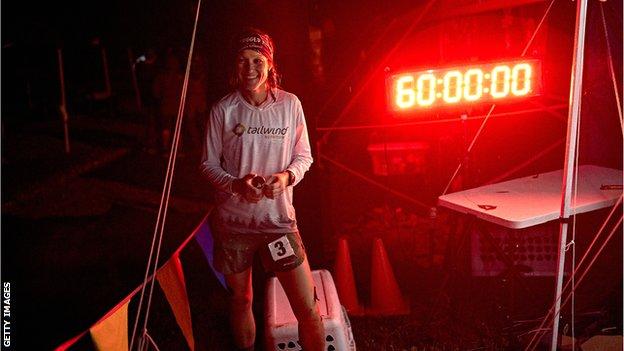
There are other problems inherent in a race that has no set finish line: Guterl almost missed her flight home the year she won because she ran for 60 hours; runners go without sleep for so long that they start hallucinating; and just how do you convince yourself to keep moving when you’re a physical and mental wreck and the easiest thing in the world is to stop?
All of which prompts another question: why put yourself through it?
“It doesn’t feel like a race,” says 40-year-old Guterl, who has taken part in Big’s for the past three years. “It’s super fun.”
Johan Steene, a 47-year-old chief executive of a Swedish technology company who clocked up 283 miles in 68 hours to win in 2018, describes it as a “special game with fantastic rules”.
“It’s a fun mental challenge,” says American Courtney Dauwalter, runner-up to Steene with 279 miles and a big enough star in the niche world of ultra-running to be a guest on the Joe Rogan Experience podcast.
A 36-year-old former science teacher who is now one of very few professional ultra-runners, Dauwalter is no stranger to unfathomably long races. In 2017 she was outright winner of the Moab 240 – a 240-mile race over the mountains of Utah – beating the fastest man by 10 hours.
For her, Big’s is about “finding out what’s possible rather than a race that you want to win. If we don’t limit ourselves, it’s pretty cool what can happen.”
Guterl, Dauwalter’s friend and occasional training partner, agrees. “In this race you can bust through as many walls as you want.”
It makes for a strange spectator sport. Wearing anything from baggy shorts (Dauwalter’s are so celebrated they have their own Twitter account) to a cowboy hat (Proctor describes it as a “working hat”), competitors look nothing like stereotypical marathon runners.
Many chat among themselves as they saunter around the course. Andy Persson, one of the few Britons to have taken part in the race, made videos as he ran 135 miles in 2019. Proctor likes to phone family and friends, although he had to rethink his strategy after falling over while speaking to his seven-year-old daughter. “I yelled and swore. She was scared and didn’t want to talk to me on the phone any more.”
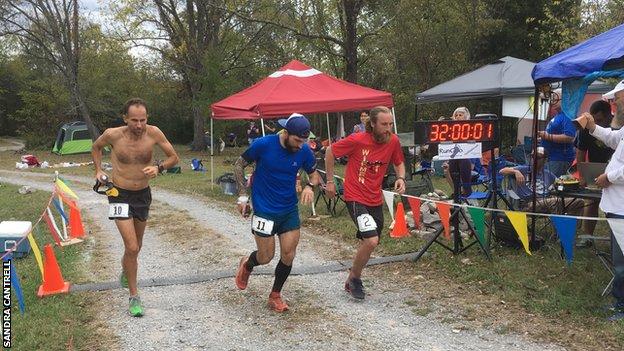
Runners must be inside the starting corral (a hand-painted box on a dirt track) when Cantrell rings a bell to signal the beginning of every lap, which he set at 4.16666 miles because 24 hours adds up to 100 miles. Anyone who doesn’t line up at the start is timed out.
The inflatable banner at the finish line has been cruelly doctored to add three crucial words, so it now reads ‘There is no finish’. And, just to mess with runners’ heads even more, there are jeerleaders – mischievous fans who heckle runners every lap with songs reminding them how weak they are and how easy it is to quit.
“The start line is the absolute hardest part,” says Proctor. “I saw countless runners running well and they didn’t go to the start line. It’s not the five yards to get there – it’s the decision to get off your feet.”
Proctor’s preparation for Big’s included blowing a whistle twice at random moments at home to mimic Cantrell’s two-minute warning before each lap.
“We get triggered by things all the time – the smell of foods, your alarm in the morning,” says Proctor. “I would blow my whistle and hug my kids. I would blow my whistle and eat cookies. I didn’t have one negative experience to that whistle in the race. I always wanted to hear it.”
“It’s all in your head,” says Cantrell, who launched Big’s in 2011 because he wanted a race that rewarded runners who were the toughest mentally rather than the fastest or fittest. “It’s a war between your mind and your body.”

Events like this are typical of Cantrell. Also known as Lazarus Lake, the man with the beard and the beanie has become a legendary figure in the running community as the founder of the notorious Barkley Marathons, made famous by a Netflix documentary and widely accepted as one of the hardest foot races on the planet with a failure rate of 99%.
He also organises a race in which runners are driven 350 miles on a bus, dropped in the middle of nowhere and told to make their way back within 10 days.
“They are the races that I would like to do myself,” says Cantrell, a former ultra-runner who was still fit enough to walk 3,200 miles across the United States in 126 days in 2018. He says he is 43, but admits he has been saying that for several years now.
Cantrell was once described by a runner as “the Leonardo da Vinci of pain, the Rembrandt of mind games, the Lady Gaga of suffering”.
There is care in his creations, though.
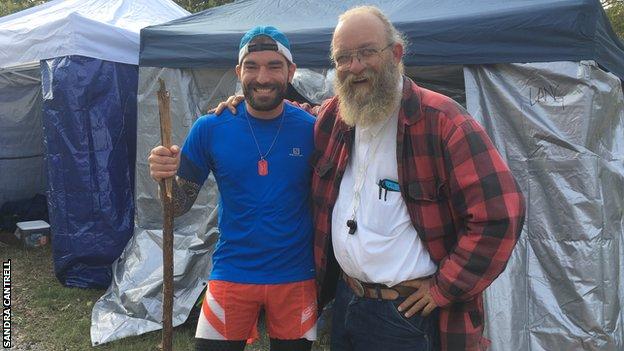
“He gets called a sadist and that he likes people to suffer, but he’s not like that,” says 31-year-old Karel Sabbe, the Belgian dentist who is also among the 99% of non-finishers at Barkley. “He gets the best out of people. He wants everybody to have the opportunity to face their own limits.”
Persson calls Cantrell a genius – “he has created a very special thing” – while Steene, a man who lives by the motto ‘run far, be nice’, says: “Laz has given me things I couldn’t have got myself. I love him deeply.”
Guterl recalls a conversation with Cantrell in which he likened the runners to “a bunch of amoebas on a slide under a microscope”. Proctor says: “He gets into the mind of all of us endurance athletes – the why and the how and the spirit of what we do.”
But how do runners actually get their head around not knowing whether a race will end in six hours or 60 hours? The verdict from the most successful competitors is simple: don’t even attempt to.
“It’s really dangerous to think,” says Steene. Dauwalter describes it as running in “robot zone”. Proctor says: “We’re crippled by the past and the future. What’s happening in the next 10 seconds is all that I can control.” Guterl’s approach is cheery and ruthless in equal measure: “You’re not waiting for the end; you’re waiting for the game to start.”
A mental battle it may be, but looking after the body is key. Aching joints are a given, blisters common and twisted ankles never more than a stray footstep in the woods away.
Most runners will elevate their legs between laps. Guterl uses a massage gun on her overworked muscles. Proctor wears electronic recovery pants to stimulate blood flow.
Eating – and a lot of it – is non-negotiable. Although some runners are scientific in terms of calories, most are happy to swallow whatever their stomach can handle, no mean feat when it has been working overtime for a day or more.
Powered by “spaghetti and potato chips”, Sabbe ran for 312 miles in the Belgium edition of Big’s in 2020 to claim the world title (satellite ‘world championship’ events sanctioned by Cantrell were staged around the world because coronavirus prevented people from travelling to Tennessee).
Steene is a big fan of Greek yoghurt with honey. Guterl raves about pierogi, a type of Polish savoury dumpling. Mashed potatoes and porridge suit Persson, although he points out: “You get to a point where you don’t feel like eating. You really have to force it down.”
Proctor’s go-to is pie in a bag – “if anybody doesn’t like pie I don’t want to know them” – and he makes sure to eat on the move. “The break between laps can be many things. For me, it’s a digestion break. Once I stop running, because my heart rate is up I process food lightning fast.”
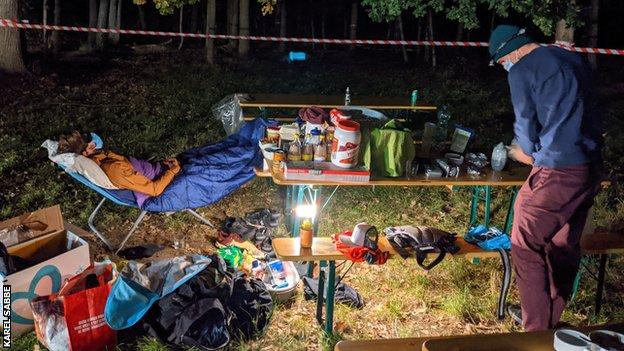
That precious time between laps – which ranges from a few seconds for the slowest runners to 20 minutes for the quickest – is the only chance they get to sleep.
“Running is the easiest part; sleep is the hardest,” says Steene. “I talk to people on the loop. I don’t speak between loops. That is my time – you have to make every minute count.”
“Johan is a master of the instant sleep,” says Cantrell, who has to stay awake for much of the race himself. “He sits down in his chair and throws a blanket over his head. He’s asleep before the blanket lands across his face.”
Even with a few power naps, Steene couldn’t stave off hallucinations – trees and bushes took the shape of dinosaurs and giants – while Guterl saw severed heads and heard growling in the woods.
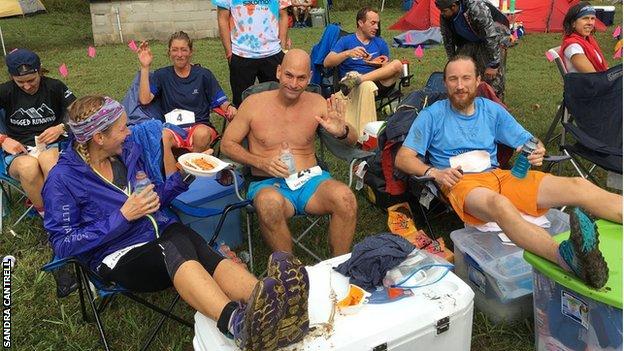
Far from putting them off, the physical and mental pain of competing at Big’s is a selling point for this seemingly masochistic band of athletes.
“You go through big dips. That’s something I love about ultras – you learn a lot about yourself,” says 56-year-old Persson, who ran 800 miles from Lands’ End to John O’Groats in 17 days in 2016 and whose passion for the sport recently persuaded him to change careers to become a counsellor specialising in therapy sessions that combine talking and running.
Steene’s advice is simple: “Accept the pain – don’t be scared of it.”
It is all relative for Proctor, who has an app on his phone called WeCroak, which tells him five times a day how long he has left to live – as a reminder not to waste his life. “The chair that you’re sitting in right now – is that comfortable? Go and run 50 loops of a 4.17-mile course, then sit down in that chair and I’ll ask you if it’s comfortable.
“We live in a perfect world where you can go to a grocery store with 20,000 food items. And we’re going to complain about what’s hard…? I want to go to a place where I strip everything away. That’s the moment when you find out most about yourself. I wish that experience upon everybody.”
This is a man who once ran 100 miles to the start of a 100-mile race, then won the race in a record time. And who will this year attempt to run 4,500 miles across Canada in a record 67 days – an average of 67 miles a day – to help raise funds for his 12-year-old son Sam, who has a rare genetic disorder that makes simple movements difficult.

Proctor says: “There are so many parallels at Big’s to what is difficult and challenging in life. But the challenges are on crack – because it all happens within a couple of days. In those days you will be at the highest and lowest moments of your entire life. You can find true transcendence.”
During tough spells in Big’s, Guterl, who works for a sports nutrition company, reminds herself that “this is not my real job”, even if she admits that the smiles and high fives don’t tell the full story. “If you can fake it to yourself, you’re halfway there.”
The equally upbeat Dauwalter points out: “We are doing this for fun – and we chose to do it.” Sabbe equates being a happy person to being a stronger ultra-runner. “Having a great time is rule number one,” agrees Calmettes.
Such tactics are not only for a runner’s own benefit. After all, the only way to win is for everyone else to pull the plug. Cantrell describes the race as “half running, half poker”, adding: “Everybody acts like they feel great – when you know they’ve been dying for hours.”
“You can’t trust what you see,” says 37-year-old Calmettes. “The real face of people is the face they have in their tent, when nobody sees them.”
Guterl says some competitors keep secret the times of their flights home, for fear of revealing their end point. Proctor, one of the quickest runners, wears a waist lamp rather than a head lamp on the night loops so his rivals don’t know when he turns to look behind. “I want to show extreme confidence.”
But one of the unique twists at Big’s is that those aiming to reach their limit don’t want others to quit too early. “I need them to be great for me to be great,” says Dauwalter, who ran 67 laps – 279 miles – to finish second in 2018 and went one lap further to take the US title in Tennessee in 2020.
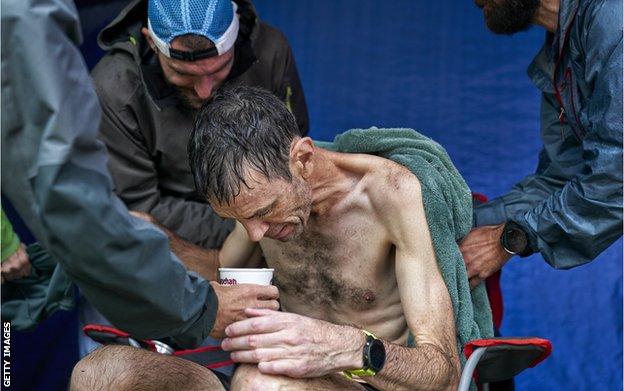
The best example of this paradox was 2019, when Guterl and Will Hayward, a 51-year-old New Zealander, were the final two runners after 52 hours. Guterl felt fresh. A gaunt Hayward, struggling with diarrhoea and having to be helped into the starting corral, did not. Victory for Guterl seemed assured, but she wanted to reach 72 hours, and 300 miles.
“Will looked terrible and someone said he was going to drop,” recalls Guterl. “I said ‘this can’t happen’. Guillaume said ‘I got this’ and jumped in to crew Will, who stayed in the race. At some point Will picked up and I thought ‘what have I done here?’ He stayed in for about another eight hours.”
Hayward eventually fell asleep in the woods and missed the cut-off, but the majority of runners make the decision to pull out before their body fails them. “Normally they stop and hug you,” says Proctor. “It becomes quite an emotional thing. People are crying out on the course.”
Persson, who was 13th in 2019, says: “When you finish there’s a big relief – I don’t have to do that again. But you are always thinking, ‘I could have gone further’.”
Calmettes, the 2017 champion, was fifth with 225 miles in 2018 and was forced out by a knee injury after 96 miles in 2019. “If you finish and you see other people continuing into the race, you start to feel guilty,” he says.
Sabbe says: “I decide beforehand that I won’t quit. I take the decision-making out of it before I start. I’m not in extreme pain. I’ve not got an injury. I am here until I can’t run any more.”
The moment of victory for Sabbe was a mixture of confusion and relief. “It’s hard to be excited. Your brain isn’t working properly. Five or six times I had to ask if it was finished because I was too dumb.”
Steene’s reaction to winning was anything but euphoric. “I didn’t feel happy. The game was over,” he says. “I had no motivation for that last lap. That was the hardest one.”
Calmettes was “really angry” in 2017 when his partner in the final two, Harvey Lewis III, dropped. “It was 59 laps, not 60 – that would have been a better number.”
But even a sleep-deprived Guterl knew her 2019 victory was a landmark moment for women’s sport. “The wife of one of the runners said I was running for an entire gender,” she says. “It definitely kept me motivated. I’m not fast, but I’ve always been stubborn. Once I get an idea in my head I am not going to let it go.”
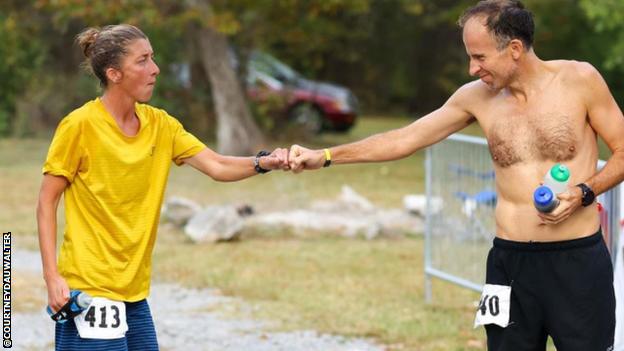
Cantrell says picking a favourite edition of Big’s is “like asking which is my favourite child”, but seeing a woman win was special. “When you remove speed and strength from the equation, you have women competing head on with the men. Maggie and Courtney – they’re just competitors.”
The prize for winning used to be a military dog tag. Now it’s a gold coin. And a hug from Cantrell if you’re lucky.
“If you’re in it for fame, it’s not for you,” says Guterl. Calmettes backs her up. “You do it for the experience. It’s an adventure. But the story of this adventure, you don’t know.”
The distances the leading runners clock up have exceeded what even Cantrell considered possible when he first came up with the concept of a race with no finish line.
“It’s crazy what people do nowadays. If we get all the champions back at Big’s, you don’t know how far the winner could go,” he says.
Competition has never been stiffer. The success of Big’s has spawned almost 200 sanctioned races in 43 countries, with some winners guaranteed ‘golden tickets’ to the main event.
Calmettes, champion in 2017, insists he will return to Tennessee. So too 2018 winner Steene. Guterl wouldn’t miss it for the world. And Sabbe says he wants to taste the authentic Big’s experience after his record-breaking triumph in Belgium in 2020.
Guterl is not alone in thinking 100 hours – a scarcely believable 400 miles – is possible. “I want to get there,” she says.
“I don’t like to set targets, but if I get to 400 miles maybe I would stop. Then again, if someone went and beat 400, I would have to come back.”
 Home Of Ghana News Ghana News, Entertainment And More
Home Of Ghana News Ghana News, Entertainment And More





